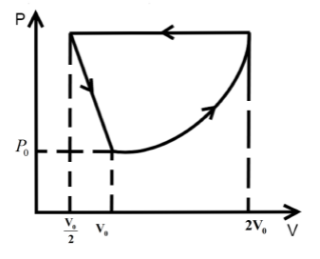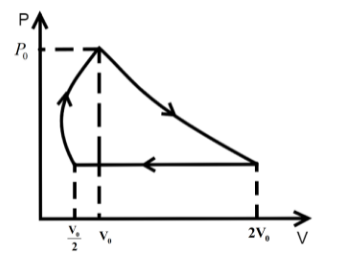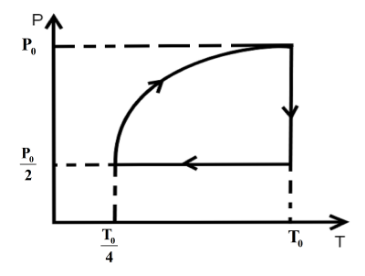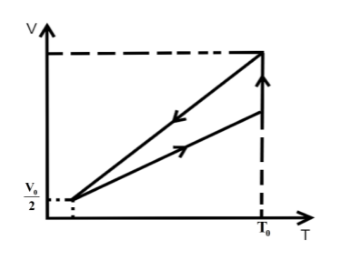
One mole of an ideal gas at pressure \[{P_0}\] and temperature \[{T_0}\] volume \[{V_0}\] is expanded isothermally to twice its volume and then compressed at constant pressure to (\[\dfrac{{{V_0}}}{2}\]) and the gas is brought to original state by a process in which \[P \propto V\] (Pressure is directly proportional to volume): The correct representation of process is :
A.

B.

C.

D.





Answer
463.8k+ views
Hint:In an isothermal process the temperature of the reaction is kept constant and the P-T or V-T curve is straight parallel to the T axis. For an isobaric process the pressure of the reaction is kept constant and the P-V or P-T curve is straight parallel to the P axis.
Formula used:
Boyle’s law for ideal gas is given by,
\[PV = k\]
where \[P\] is the pressure of the gas, \[V\]is the volume of the gas and \[k\]is constant.
Charles’s law for ideal gas is given by,
\[V = kT\]
where, \[V\] is the volume of the gas, \[T\] is the absolute temperature of the gas and \[k\]is constant.
Complete step by step answer:
We know that in an isothermal process the temperature of the reaction is kept constant while other parameters of the equation of state vary .So, for an isothermal process the P-T or V-T curve is straight parallel to the T axis. Here, it is expanded to keep the temperature constant. So, from Boyle’s law we can get the final pressure as, \[{P_0}{V_0} = {P_2}2{V_0}\] when, \[T = k\] is constant.
\[{P_2} = \dfrac{{{P_0}}}{2}\]
In the second step the pressure is kept constant and we know for an isobaric process the pressure of the reaction is kept constant while other parameters of the equation of state vary. So, the P-V or P-T curve is straight parallel to the P axis. So, from Charles law we can get final temperature in the process as, \[\dfrac{{2{V_0}}}{{{T_0}}} = \dfrac{{{V_0}}}{{2{T_2}}}\] when \[P = k\] is constant.
\[{T_2} = \dfrac{{{T_0}}}{4}\]
In the third step the \[P \propto V\] so P-V curve is parabolic in this process so coming back to the initial state will be a parabolic path in the P-V curve. Since, \[P \propto V\] from ideal gas relation we can write \[P \propto \dfrac{T}{P}\] .
\[{P^2} \propto T\]
So, the state parameter of the gas changes as,
\[{P_0},{V_0},{T_0}\xrightarrow[{process}]{{isothermal}}\dfrac{{{P_0}}}{2},2{V_0},{T_0}\xrightarrow[{process}]{{isobaric}}\dfrac{{{P_0}}}{2},\dfrac{{{V_0}}}{2},\dfrac{{{T_0}}}{4}\xrightarrow{{P \propto V}}{P_0},{V_0},{T_0}\]
So, the P-T curve can be drawn as,

Hence, option C is the correct answer.
Note:To draw the curve, always deduce the state parameters \[P,V,T\] first using the equation of states at the end of each process to mark the values in the curve. In adiabatic processes the total exchange of heat in the process is always zero. Adiabatic process follows the equation \[P{V^\gamma } = k\] where \[\gamma \]is the ratio of the molar specific heats i.e. the ratio of the molar specific heat at constant pressure to the molar specific heat at constant volume.
Formula used:
Boyle’s law for ideal gas is given by,
\[PV = k\]
where \[P\] is the pressure of the gas, \[V\]is the volume of the gas and \[k\]is constant.
Charles’s law for ideal gas is given by,
\[V = kT\]
where, \[V\] is the volume of the gas, \[T\] is the absolute temperature of the gas and \[k\]is constant.
Complete step by step answer:
We know that in an isothermal process the temperature of the reaction is kept constant while other parameters of the equation of state vary .So, for an isothermal process the P-T or V-T curve is straight parallel to the T axis. Here, it is expanded to keep the temperature constant. So, from Boyle’s law we can get the final pressure as, \[{P_0}{V_0} = {P_2}2{V_0}\] when, \[T = k\] is constant.
\[{P_2} = \dfrac{{{P_0}}}{2}\]
In the second step the pressure is kept constant and we know for an isobaric process the pressure of the reaction is kept constant while other parameters of the equation of state vary. So, the P-V or P-T curve is straight parallel to the P axis. So, from Charles law we can get final temperature in the process as, \[\dfrac{{2{V_0}}}{{{T_0}}} = \dfrac{{{V_0}}}{{2{T_2}}}\] when \[P = k\] is constant.
\[{T_2} = \dfrac{{{T_0}}}{4}\]
In the third step the \[P \propto V\] so P-V curve is parabolic in this process so coming back to the initial state will be a parabolic path in the P-V curve. Since, \[P \propto V\] from ideal gas relation we can write \[P \propto \dfrac{T}{P}\] .
\[{P^2} \propto T\]
So, the state parameter of the gas changes as,
\[{P_0},{V_0},{T_0}\xrightarrow[{process}]{{isothermal}}\dfrac{{{P_0}}}{2},2{V_0},{T_0}\xrightarrow[{process}]{{isobaric}}\dfrac{{{P_0}}}{2},\dfrac{{{V_0}}}{2},\dfrac{{{T_0}}}{4}\xrightarrow{{P \propto V}}{P_0},{V_0},{T_0}\]
So, the P-T curve can be drawn as,

Hence, option C is the correct answer.
Note:To draw the curve, always deduce the state parameters \[P,V,T\] first using the equation of states at the end of each process to mark the values in the curve. In adiabatic processes the total exchange of heat in the process is always zero. Adiabatic process follows the equation \[P{V^\gamma } = k\] where \[\gamma \]is the ratio of the molar specific heats i.e. the ratio of the molar specific heat at constant pressure to the molar specific heat at constant volume.
Recently Updated Pages
NCERT Solutions For Class 4 English Marigold (Poem) - Don’t Be Afraid Of The Dark

NCERT Solutions For Class 5 English Marigold (Poem) - Class Discussion

NCERT Solutions For Class 5 English Marigold - Gullivers Travels

NCERT Solutions For Class 5 Hindi Rimjhim - Bagh Aaya Uss Raat

NCERT Solutions For Class 8 Hindi Bharat Ki Khoj - Tanaav

NCERT Solutions For Class 12 Maths - Differential Equations

Trending doubts
1 ton equals to A 100 kg B 1000 kg C 10 kg D 10000 class 11 physics CBSE

Difference Between Prokaryotic Cells and Eukaryotic Cells

One Metric ton is equal to kg A 10000 B 1000 C 100 class 11 physics CBSE

1 Quintal is equal to a 110 kg b 10 kg c 100kg d 1000 class 11 physics CBSE

Proton was discovered by A Thomson B Rutherford C Chadwick class 11 chemistry CBSE

Draw a diagram of nephron and explain its structur class 11 biology CBSE




